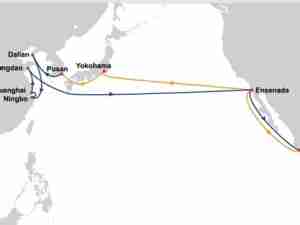Ocean carrier CMA CGM announced it will cap its ocean spot rates – which have climbed for more than a year – until February. Prices were in fact level this week. But with Asia-US rates about 13X their pre-pandemic level and the cap not applied to surcharges and premiums, many shippers are skeptical.
In any case, the impact of the announcement will soon be put to the test as Typhoon Chanthu has closed ports in Shanghai and Ningbo, and will cause delays and backlogs that could put pressure on rates.
Asia-US rates:
Analysis
- Asia-US West Coast prices (FBX01 Daily) went unchanged at $20,586/FEU. This rate is 453% higher than the same time last year.
- Asia-US East Coast prices (FBX03 Daily) were also stable at $22,173/FEU, and are 395% higher than rates for this week last year.
After fifteen consecutive months of ocean rate increases and a 7X climb in the FBX global benchmark, ocean carrier CMA CGM announced it would halt any further spot rate increases on all its services until February (Hapag-Lloyd shared that it had already capped their spot rates a couple weeks ago).
The reprieve, though welcome, was met with skepticism from many in the industry that – with rates still sky high and the cap only applied to base rates and not to surcharges and premiums which could still increase – the announcement may be more for PR than anything else.
Transpacific and Asia – Europe rates did in fact stay level this week. But that price stability will be put to the test in the coming days: Typhoon Chanthu is battering Shanghai with severe rain and winds expected to last through Thursday. With ports in Shanghai and Ningbo closed by the storm, backlogs and delays will effectively remove capacity while demand continues to surge.
The rebound in US consumer spending on services that started this summer and was seen as one key to normalizing ocean demand after peak season has receded as the Delta variant continues to spread. And with peak season in full swing, the latest National Retail Federation estimates had August’s US ocean imports 16% higher than in August 2019, and September not far behind. Other observers now do not expect any significant easing of demand (or rates) until summer 2022.
Supply chain backups are also leading some small manufacturers in China to decline new orders as they struggle to ship finished goods and pay for raw materials with cash flows stalled, possibly representing a new challenge for some importers.
Though air cargo rates out of China have stabilized as Pudong continued to recover from the recent COVID outbreak, the typhoon has closed airports around Shanghai, adding a new disruption to air cargo which could push prices up again soon.






